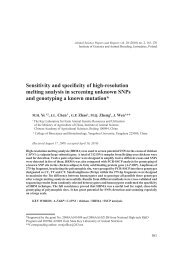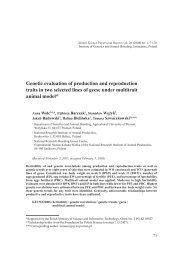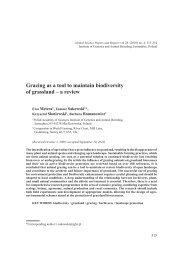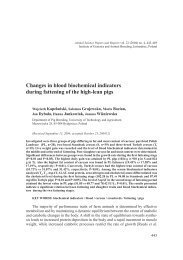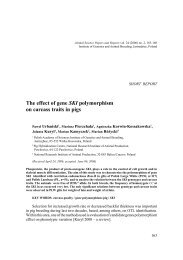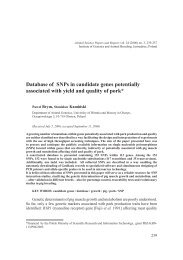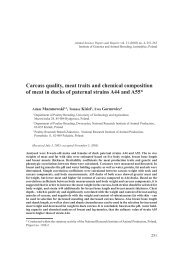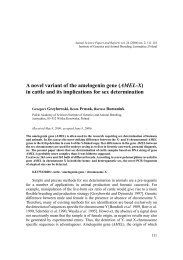Preliminary observations on the Echinacea-induced lactoferrin ...
Preliminary observations on the Echinacea-induced lactoferrin ...
Preliminary observations on the Echinacea-induced lactoferrin ...
Create successful ePaper yourself
Turn your PDF publications into a flip-book with our unique Google optimized e-Paper software.
<strong>Echinacea</strong>-<strong>induced</strong> <strong>lactoferrin</strong> producti<strong>on</strong> in goat milk<br />
fur<strong>the</strong>r studies <strong>on</strong> animals are necessary in order to establish <strong>the</strong> optimum period of<br />
treatment, as well as <strong>the</strong> safe and effective daily dose of <strong>Echinacea</strong> purpurea, in whatever<br />
form it may be. The easiest and cheapest would be <strong>the</strong> use of dried plants. However,<br />
establishing <strong>the</strong> level of active ingredients of <strong>Echinacea</strong> purpurea depending <strong>on</strong> <strong>the</strong><br />
phase and c<strong>on</strong>diti<strong>on</strong>s of growth and drying would be a problem.<br />
It can be c<strong>on</strong>cluded that <strong>the</strong> efficiency of Echinapur preparati<strong>on</strong> exceeded <strong>the</strong> expectati<strong>on</strong>s.<br />
A significant rise of Lf c<strong>on</strong>tent of milk as a result of stimulating <strong>the</strong> immune<br />
system of goats with <strong>Echinacea</strong> purpurea extract may provide a model for producti<strong>on</strong><br />
of milk with increased anti-bacterial properties. A significant lowering in SCC and CFU<br />
in milk of goats receiving Echinapur points to <strong>the</strong> feasibility of using <strong>the</strong> preparati<strong>on</strong><br />
to achieve beneficial changes in health of <strong>the</strong> mammary gland, and simultaneously an<br />
improvement in <strong>the</strong> hygienic and health-promoting quality of milk. The preparati<strong>on</strong><br />
does not induce negative changes in <strong>the</strong> c<strong>on</strong>tent of basic milk comp<strong>on</strong>ents with <strong>the</strong><br />
excepti<strong>on</strong> of a transient but significant decrease of <strong>the</strong> protein c<strong>on</strong>tent.<br />
Although <strong>the</strong> results presented here must be treated as preliminary, <strong>the</strong>y suggest <strong>the</strong><br />
potential feasibility of applicati<strong>on</strong> of <strong>Echinacea</strong> as a immunostimulating feed additive.<br />
REFERENCES<br />
1. BELLAMY W., TAKASE M., YAMAUCHI K., WAKABAYASHI H., KAWASE K., TOMITA M.,<br />
1992 – Identificati<strong>on</strong> of <strong>the</strong> bactericidal domain of <strong>lactoferrin</strong>. Biochimica et Biophysica Acta 1121,<br />
130-136.<br />
2. BEZAULT J., BHIMANI R., WIPROVNICK J., FURMANSKI P., 1994 – Human <strong>lactoferrin</strong> inhibits<br />
growth of solid tumors and development of experimental metastases in mice. Cancer Research 54,<br />
2310-2312<br />
3. BURGER R.A., TORRES A.R., WARREN R.P., CALDWELL V.D., HUGHES B.G., 1997 – <strong>Echinacea</strong>-<strong>induced</strong><br />
cytokine producti<strong>on</strong> by human macrophages, Internati<strong>on</strong>al Journal of Immunopharmacology<br />
7, 371-379.<br />
4. CHANG J., 2000 – Medicinal herbs: drugs or dietary supplements? Biochemical Pharmacology 59,<br />
211-219.<br />
23



